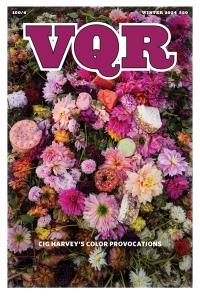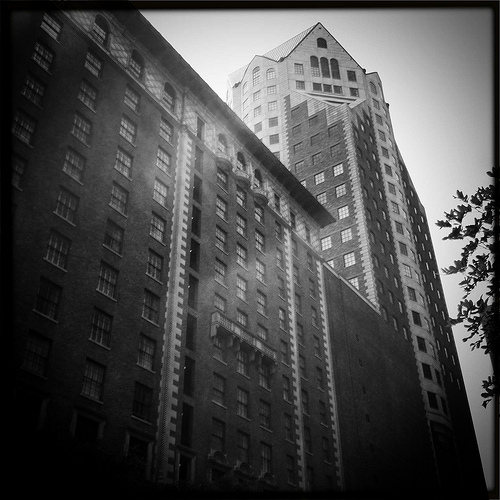
The Haunted Hotels of Los Angeles


Why does Elizabeth Short—the Black Dahlia—haunt the Biltmore Hotel in downtown Los Angeles? True, it was the last place she was seen alive, but why doesn’t she haunt the sad stretch of sidewalk in South Los Angeles where her body was found? Why doesn’t she haunt wherever she was actually murdered? Why does she haunt LA at all?
The Biltmore is old Hollywood, Classic Hollywood. Opened in 1923, at the time the largest hotel west of Chicago, it displaced the nearby, equally opulent Alexandria as the epicenter of LA glamour. It was here, in the grand Crystal Ballroom, that the Academy of Motion Picture Arts and Sciences was founded in 1927, and where eight early Academy Awards ceremonies were held, beneath ground in the hotel’s banquet room, the Biltmore Bowl.
I’ve been to the Biltmore Bowl twice, once for a booksellers’ association event, and once on New Year’s Eve when, on a whim, friends and I hopped a velvet rope and descended into the bowels of the hotel, finding the Biltmore Bowl by accident, unlocked, completely dark but for the red exit sign. We walked through the red-tinged blackness, expecting, I suppose, the room to erupt with ghosts at any minute. In that cavernous abyss, it felt as though we were a hundred, five hundred feet below the surface. There’s yet another conference room beneath this one, the Regency Room, and it seemed that these empty banquet rooms would go further and further into the earth, never ending.
I understand why people feel the Biltmore is haunted. I’ve stayed there, heard the heating pipes creak and tick in unpleasant, unfamiliar ways, as though the whole building were alive, breathing. I’ve stared down its desolate hallways, half-assuming that some vague butchery was taking place behind one of those doors, something to be hushed up and forgotten, something whose trace would come to inhabit the walls like a stain—even as its grand ballrooms still speak to the glory and promise of Hollywood. In October of 2010, a woman named Laura Finley fell six flights down the stairwell to her death; while her half-naked body was lying in the stairwell, her husband was in the lobby, auditioning in front of Piers Morgan, Sharon Osbourne and Howie Mandel for the next season of America’s Got Talent. As though these things happen all the time. As one former employee later claimed in regards to Finley’s death, “Lots of employees, even security, didn’t like working the graveyard shift there due to a lot of ghostly presence. … People might say ghosts don’t exist. Try staying there. I know—I have experienced it myself.”
All hotels are haunted. It doesn’t matter which hotel; it’s already played host to a murder, an overdose, an accidental death with a story. You’re kidding yourself if you don’t see this, if you don’t recognize you sleep with ghosts. Every hotel staff has its stories, any cleaning woman or bellhop knows the score. In Wilkie Collins’ 1878 gothic novel The Haunted Hotel, an Italian villa is converted to a hotel shortly after it houses an unexplained, horrific tragedy. On opening night, a guest (“not a superstitious man”) takes Suite 14, and leaves hurriedly the following morning. The next night another couple take the suite; throughout the night the woman has horrifying dreams—awake, “afraid to trust herself again in bed,” she too makes excuses and leaves.
Assume, then, that every nightmare you’ve ever had in a hotel was a cry for help, some violence from the past reaching out to you.
How else to explain these feelings we all have in such buildings, like the feeling I had when I was in the old Glen Donald Apartment Building, itself a former hotel just off MacArthur Park? It was a few years ago, a Halloween party, and the residents had dressed in Roaring Twenties costumes, gliding down the stairs in flapper dresses and pinstripes. I felt it then, the strange sense of unease that old former hotels exude, that strange sense of presence lurking in the shadows, in the wood and plaster. How could I have known then that beneath our feet in the basement was a steamer trunk, still undiscovered, containing the mummified remains of two tiny children? That trunk belonged to a woman named Janet M. Barrie, and they were her children, one possibly a stillborn birth, wrapped in newspaper (from 1932 and 1934, respectively). With them in the leather case was a copy of Peter and Wendy and a membership card for a posh resort called the Peter Pan Woodland Club, leading some to believe she was somehow related to the author J. M. Barrie. This turned out to be untrue, but the actual story of these children—did she kill them? who was the father? how did they end up there?—remained elusive.
Then there’s the Alexandria Hotel, now also apartments, where supposedly Rudolf Valentino still dances under its oval skylight. Valentino also haunts the Knickerbocker Hotel, converted into a retirement home, along with the ghosts of Elvis Presley (haunting the perennially cold Room 1016), and William Frawley (Fred Mertz from I Love Lucy, who dropped dead in the Knickerbocker’s foyer). Frances Farmer was dragged from the Knickerbocker to be institutionalized against her will, and the fashion designer Irene Lutz jumped from its roof in 1962, distraught over the death of Gary Cooper. Marilyn Monroe, too, haunts the Knickerbocker, but she also haunts Cabana Room #246 at the Roosevelt Hotel on Hollywood Boulevard, where she shares duties with the malicious spirit of Montgomery Clift. Carole Lombard, Clark Gable, and Harry Lee all have been seen at the Roosevelt, too, to say nothing of the various non-celebrity ghosts who supposedly taunt and trick the guests there. The Culver Hotel hosts the ghostly remains of the dwarf actors who played the Munchkins in The Wizard of Oz, filmed across the street at Sony Studios; it’s their voices you hear conspiratorially whisper as you move through its halls. And finally there’s the Hollywood Tower, a hotel so famous for its ghost stories that Disney World built a ride based on it.
These hotels themselves are ghosts of Old Hollywood: once shining, young, beautiful, they aged, declined, became sad and washed out, and then at some point, died unglamorous deaths, and yet stubbornly live on. Once the haunt of the film industry’s glitterati, the Alexandria gradually entered bankruptcy, became a flop house, then a boxing gym. Somehow it was never destroyed, lingering like a shade in a vacated downtown. Walking through these spaces, you see glimpses—a skylight or a chandelier—that hint at a former glory, but things will never be the same. The hotels have become palimpsests, written over and over with the decades of a changing city, so that only fragments of the past can be seen—reminders of what once was. These ghost stories are really about a nostalgia for that faded past, a former glory in which Rudolf Valentino broke hearts and danced the night away under golden chandeliers, where rowdy but good-natured stars drank away the Prohibition nights. Before the Depression, before the Hays Code, before the party ended, before the lights went out.
But the famous ghosts are the least interesting spirits that Hollywood has to offer. The post-mortem celebrity sightings have their tragic elements, to be sure, but they’re banal, overworked to the point of melodrama and cliché, and the nostalgia is predictable. You can’t hope to understand Hollywood, its glory and debauchery, if all you care about is Rudolf Valentino or Marilyn Monroe. You have to seek out the forgotten stories: the janitor who supposedly lingers in the Roosevelt, the woman in the flapper dress who rides the elevators in the Alexandria, the two children who linger in the Glen Donald. You have to seek out the darker side to Classic Hollywood, a dark side to the promise that lured so many starlets and other hopefuls to LA throughout the past century and delivered only tragedy. Expecting fame, expecting a life, expecting a short stay in a hotel before moving onto a palatial mansion, some of them met another side to the city, like the young starlet Virginia Rappe, dead from a ruptured bladder after a wild hotel party involving Roscoe “Fatty” Arbuckle, perhaps dead from a violent rape, or perhaps due to resulting complications from a botched abortion. Or the aspiring actress Elizabeth Short, brutally dismembered and left as a grotesque calling card, who now haunts the Biltmore. Or the ghost in Room 120 of the Aztec Hotel, along Route 66 in nearby Monrovia, who some claim was an aspiring actress killed during a fight with her husband.
Unlike the well-chronicled stories of celebrities, these ghost stories of Hollywood are often fragmented, incomplete. They don’t just reflect a tragic, darker history that’s best forgotten. They offer something far more terrifying: a story without a final answer, without a perfect resolution. Perhaps that’s why we continue to tell these ghost stories—Hollywood was built on stories rigid in their perfection, the three-act structure with its lock-step resolution and neat denouement. Ghost stories are the opposite: hints of a narrative that will always be fragmentary, that can’t be explained away. That’s why they cling to Hollywood, why they linger underfoot.
The haunted hotel manages to record both sides of the great narrative of Classic Hollywood, its light side and its dark, kept close in tattered walls in buildings that seem to live on beyond death. It’s not the mansion of Norma Desmond from Billy Wilder’s Sunset Boulevard that best exemplifies Old Hollywood’s history. It’s the Hotel Earle, from the Joel and Ethan Coen’s Barton Fink, a building that the directors themselves described as a “ghost ship floating adrift, where you notice signs of the presence of other passengers, without ever laying eyes on any.” When Barton Fink checks in at the Earle, the desk clerk asks him, “Are you a trans, or a res?,” meaning transient or resident. Fink doesn’t get it, he’s confused, as though he’s not yet ready to commit to the implications of the question; he stammers forth a vague response: “I, uh, I don’t know. I mean, I’ll be here indefinitely.” The clerk finally answers for him.
The ghost as constructed in popular imagination is perhaps the epitome of this confusion—the remnants of a person or story that might have departed long ago but which lingers on, which can’t decide between transience and residence, which shadows in the gap between the two. And this is perhaps why the Black Dahlia haunts the Biltmore, where you feel her presence even if you don’t see her. It’s the only place a ghost like her can call home.
